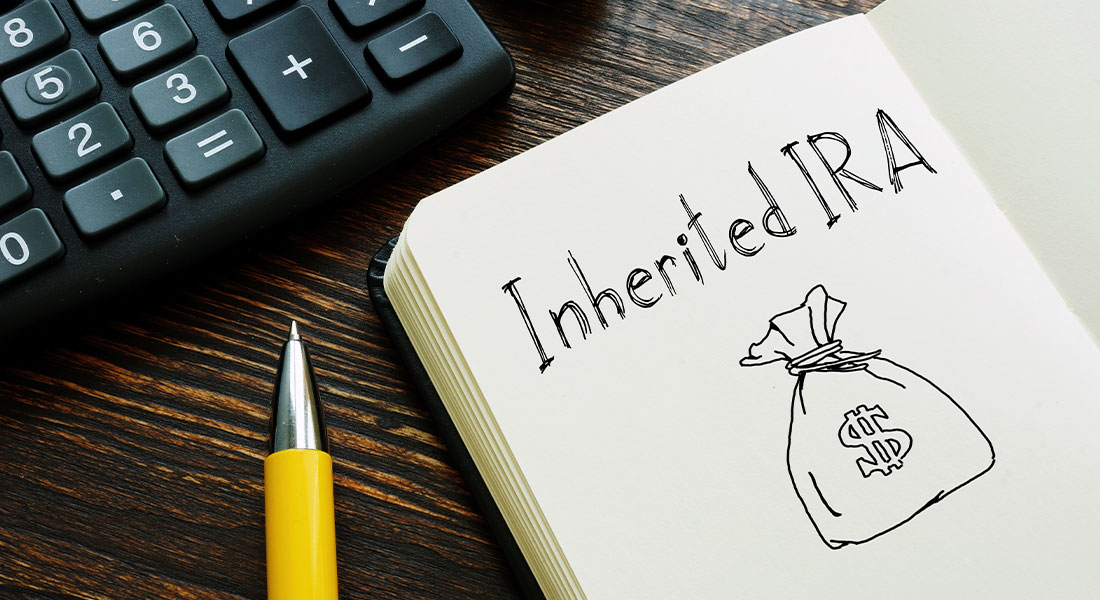 Contact
About Us
Articles
Home
Contact
About Us
Articles
Home

The idea of inheriting a windfall has great appeal. Books and movies use this as a plot device because most of us have at least some desire to inherit wealth. And, while very few people inherit royal fortunes, many people do receive inheritances of some kind, usually from parents or grandparents. While we probably spend time fantasizing about how we’d spend such an inheritance, most of us spend far less time planning how to use it smartly. However, if you receive an inheritance, especially in the form of an IRA, you’ll need to understand your responsibilities – and also make some tough decisions. This article will walk you through some of the decisions you’ll have to make and actions you’ll have to take in order to inherit an IRA and put it to maximum use.
Some of the required steps are very basic; generally housekeeping items. For instance, when the owner of an IRA passes away and you’re the beneficiary, or your children are, you’ll have to do some paperwork to receive the money. Funds in an IRA are held by financial institutions and are administered by trustees. Generally, both of these functions are performed by a brokerage company or bank. In order to receive the money, you’ll have to fill out any of their required paperwork. In addition to this, you will also have to provide them with a copy of the death certificate. This obviously means that you must have a copy of the death certificate in your possession, which means that some time may pass from the date of the IRA owner’s death until you can file a complete claim. Once you have the death certificate, you can file all the required paperwork and ask the IRA trustee for your money. It’s here that your decision making begins.
Your decisions for handling an inherited IRA fall into two broad categories:
Notice that the first question assumes that you will in fact take distributions. This is a requirement no matter how old you are when you inherit an IRA or what your relationship is to the account owner. You will absolutely be required to take distributions. The question is the value of the distributions be and time requirements to receive them.
There are two sets of rules for taking these required distributions, and they depend on what type of beneficiary you are. Remember, a beneficiary is someone who receives the proceeds from an account when the owner dies. The two types of beneficiaries are:
The rules for designated beneficiaries are simple. If you are a designed beneficiary, you must withdraw all the money in the inherited IRA within 10 years. There are no requirements for yearly distributions, so it is left up to you determine the timing and size of withdrawals. You could withdraw it all at once, or spread it out over all 10 years. The choice is yours. You will definitely want to have a strategy for receiving this money. Because these are important choices, you should make a plan for taking these distributions with a trusted financial professional. You’ll want to use these distributions to advance, as much as possible, your overall retirement and estate planning goals. If you don’t have an advisor, it would be good to use your inherited IRA as the trigger to find one. We’ll return to the topic of withdrawal planning in just a bit.
Eligible designated beneficiaries have a little more flexibility. They don’t necessarily need to withdraw all the money within 10 years. They get to use their own life expectancy, which means that they can usually stretch the distributions out over a longer time. Note, though, that a minor child can only use their own life expectancy until they reach the age of majority (usually 18, although they may be able to delay this age if they’re still in school). Once they reach this age, they then have to finish withdrawing the IRA within 10 years. The “stretch IRA” concept that was so valuable in the past was eliminated by the SECURE Act of 2019. However, EDBs definitely have some advantages over “regular” beneficiaries. These benefits mainly come in the form of a longer window of time to take withdrawals, which means smaller amounts, and lower taxes, which is an important factor.
No matter your age or income level, taking these withdrawals is going to add to your taxable income. In some cases, these amounts can move you into higher income tax bracket, which means that you’ll be higher tax rates not only on your IRA distributions, but also all of your “regular” income. You’ll want to mitigate the impact of higher taxes as much as possible. To do this, you’ll want to have a smart withdrawal strategy. The strategy should encompass both the timing of distributions as well as the future impact of taxes on the amounts withdrawn.

For instance, since you have flexibility as to the timing of distributions, you could take advantage of a decline in market values. If the inherited IRA declines in value (especially if the decline is significant, perhaps due to a major bear market), you might want to take larger withdrawals than you need to, or even take the entire distribution in one year. Since your taxes are based on value distributed, the taxable amount will be lower because of the losses on the account. In this case, you should strongly consider taking your distribution “in-kind,” which basically means re-titling the account to a taxable account, or transferring shares or ownership certificates. Why? Because if you do this, you won’t be “locking-in” a loss, which is exactly what would happen if you sold whatever securities were held in the IRA in order to distribute cash.
By taking the distribution in-kind, you will benefit from any recovery in market prices. As long as you don’t sell, these gains remain “unrealized” and therefore not subject to tax until you sell them for a profit. In this scenario, since these assets are now in a taxable account, you could hold onto them for the rest of your life, thus delaying taxes on the gains for decades. In this scenario, you take advantage of a down market to take one single, large distribution instead of a series of smaller withdrawals. This of course increases your taxes in the year of distribution but eliminates any increases in future years.
An alternative strategy would be to use the required distributions to fund some kind of tax-deferred investment. Remember, when the funds come out of the inherited IRA, you’re paying taxes. If you leave these funds in a taxable account, you are potentially subject to further taxes in the future:
In this case, you’re paying taxes twice: once at distribution and again in the future as you earn dividends, interest and investment gains. Instead, you should consider using these required distributions to fund an annuity or life insurance policy. This is especially true if you don’t have traditional long-term care insurance. In this scenario, you can use these required distributions to fund an annuity or life insurance policy that will also pay benefits if you need long-term care. This strategy has several advantages:
Again, compare this to simply investing the inherited IRA distributions in the stock market with mutual funds. You will pay taxes on every dividend or interest payment you receive. If you sell the mutual funds at a gain, you’ll pay taxes on that, too. An annuity or life insurance policy restores much of the tax-deferred benefits of the original IRA, and it can help with other things like long-term care and estate planning.
You can take these benefits even further by utilizing indexing strategies. If you use a fixed index annuity (FIA) or indexed universal life insurance policy (IUL), you have the potential to earn market-based returns while shielding the gains from taxes. Traditionally, annuities and life insurance policies pay low but fixed interest. By using indexed products, you have the ability to earn interest at rates based on the performance of one or more financial market indexes. While each annuity or life insurance contract has its own unique provisions, the possibility exists to build large cash values over the years while shielding the gains from current taxation.
Another way to only pay taxes once would be to use the distribution to fund a Roth IRA if you’re eligible to do so. You can take your required distribution for the year and re-deposit it in a Roth. Then, any earnings growth in your Roth will accumulate tax-free. For the same reason, you may want to consider employing a Roth conversion strategy with existing traditional IRAs or 401(k) accounts. You’ll need to be careful here, though: Any amounts converted to Roth are taxable, so you’ll be adding these taxable amounts to the withdrawals you’re already taking from your inherited IRA.
While we just talked about the potential for using your required distributions to fund life insurance or annuities, this will not be optimal for everyone. For instance, if you already have adequate life insurance coverage and you also have long-term care insurance, you might want to consider other alternatives. You will want to work with your financial professional to create an investment plan that accounts these factors:

Unless you absolutely need the income, it would be best to save and invest your inherited IRA withdrawals. The question is how do you do that, especially if you don’t need annuities or life insurance? Asset allocation will come into play here. Your asset allocation and risk profile will be very different if you’re 89 compared to being in your 50s.
Generally speaking, the older you are, or the more you need cash flow, the more conservative your investments should be. The 89-year-old will want to be invested mostly in cash if they are likely to need help with cash flow. On the other hand, the person in their 50s may have 15 or 20 years before they need retirement income, so they can afford to take on more investment risk, hoping to substantially build their portfolio. You will accomplish this with some kind of mix of stocks or mutual funds, bonds and interest-bearing assets. As you age, you’ll systematically reduce your exposure to stocks and mutual funds and focus more on stable-value assets. This way, you’ll have maximum cash available to fund your retirement income when you stop working.
Of course, if you are not likely to “need” the money generated from your inherited IRA and you’ve moved some of it to a Roth IRA, you can afford to “shoot for the moon” with higher-risk strategies. You could build up a substantial tax-free nest egg in this case. Upon your death, the assets will transfer to your beneficiary tax-free as long as you’ve had the Roth for more than five years.
As we’ve discussed, inheriting an IRA is a blessing, but it’s a blessing that requires you to make a lot of decisions. While there’s no way to avoid paying some taxes, there are strategies you can use to minimize your tax hit. One popular way is to use your taxable distributions to fund a life insurance policy or annuity. This will allow you to accumulate cash on a tax-deferred basis, and it can also help pay for the cost of long-term care insurance. If this strategy isn’t right for you, you may want to structure a portfolio that balances your risk tolerance to your investment time horizon. You will also want to consider using a strategy and products that don’t frequently generate taxable realized investment gains. This will cause you to pay higher and higher taxes year by year as your portfolio grows. The best way to achieve this is to work with a trusted financial professional who can help you with both insurance and investment products. Once you settle on a strategy, you’ll want to make sure you stick with it, because if you change course, you could trigger even more taxable income. By working with a pro, you can ensure that your inherited IRA is a blessing and not a tax curse.
Alliance America is an insurance and financial services company dedicated to the art of personal financial planning. Our financial professionals can assist you in maximizing your retirement resources and achieving your future goals. We have access to an array of products and services, all focused on helping you enjoy the retirement lifestyle you want and deserve. You can request a no-cost, no-obligation consultation by calling (833) 219-6884 today.


